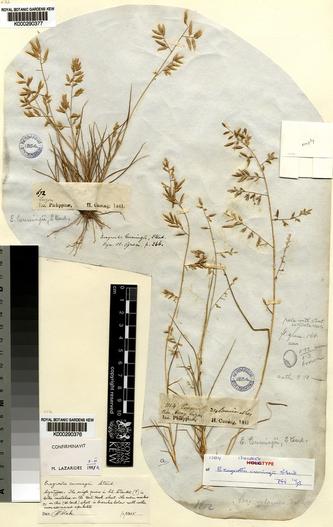Cuming’s Lovegrass
(Eragrostis cumingii)
Cuming’s Lovegrass (Eragrostis cumingii)
/
/

filibot.web
CC BY-SA 2.0
Image By:
filibot.web
Recorded By:
Copyright:
CC BY-SA 2.0
Copyright Notice:
Photo by: filibot.web | License Type: CC BY-SA 2.0 | License URL: https://creativecommons.org/licenses/by-sa/2.0/ | Uploader: filibot.web | Publisher: Flickr























Estimated Native Range
Summary
Eragrostis cumingii, commonly known as Cuming’s Lovegrass, is a semi-deciduous perennial grass native to open grasslands, savannas, and light woodlands across Southeast Asia, Oceania, and the Northern Territory of Australia. It typically grows to a height of 0.2-0.7 feet (0.06-0.2 meters) and a width of 0.1-0.3 feet (0.03-0.09 meters). This grass species forms tufts of fine-textured, green foliage that may turn brown in dry conditions, reflecting its semi-deciduous nature. It produces airy, delicate inflorescences that sway gracefully in the breeze, adding a sense of movement to the landscape.
Cuming’s Lovegrass is valued for its low water requirements and ability to thrive in poor soils, making it suitable for xeriscaping and naturalistic plantings. It is often used in rock gardens, as a ground cover, or for erosion control on slopes. While it prefers full sun, it can tolerate light shade and is adaptable to a range of soil types, provided they have slow to medium drainage. However, gardeners should be cautious as Eragrostis cumingii can become invasive outside its native range, potentially outcompeting local flora. It is recommended to consult local regulations and consider ecological impact before planting.CC BY-SA 4.0
Cuming’s Lovegrass is valued for its low water requirements and ability to thrive in poor soils, making it suitable for xeriscaping and naturalistic plantings. It is often used in rock gardens, as a ground cover, or for erosion control on slopes. While it prefers full sun, it can tolerate light shade and is adaptable to a range of soil types, provided they have slow to medium drainage. However, gardeners should be cautious as Eragrostis cumingii can become invasive outside its native range, potentially outcompeting local flora. It is recommended to consult local regulations and consider ecological impact before planting.CC BY-SA 4.0
Plant Description
- Plant Type: Grass
- Height: 0.2-0.7 feet
- Width: 0.1-0.3 feet
- Growth Rate: Slow
- Flower Color: N/A
- Flowering Season: Summer
- Leaf Retention: Semi-Deciduous
Growth Requirements
- Sun: Full Sun
- Water: Low
- Drainage: Slow, Medium
Common Uses
Bird Garden, Butterfly Garden, Drought Tolerant, Erosion Control, Low Maintenance, Salt Tolerant
Natural Habitat
Open grasslands, savannas, and light woodlands across Southeast Asia, Oceania, and the Northern Territory of Australia
Other Names
Common Names: Seaoats, 肯氏畫眉草
Scientific Names: , Eragrostis cumingii, Eragrostis bulbillifera, Eragrostis reflexa, Eragrostis simplex, Eragrostis brownei, Eragrostis distans, Eragrostis cumingii var. kisarensis, Eragrostis bleeseri, Eragrostis atrovirens subsp. ramosa
GBIF Accepted Name: Eragrostis cumingii Steud.